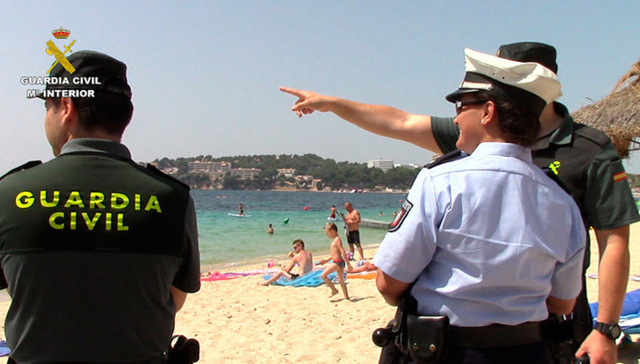Security is the second highest rated reason when choosing Spain as a tourist destination. Even the World Economic Forum indicates that the country is the second safest country among the ten leading global tourist destinations, behind only Switzerland.
In this regard, the Safe Tourism Plan, which has once again been set in motion for the 2017 season, helps the tourist sector to become more competitive, thanks to the special security measures implemented for the season, among other measures, with greater numbers of personnel in those places where this is necessary due to the mass influx of people.
A key element of the Safe Tourism Plan is carried out by the different Foreign Tourist Assistance Services (SATE) distributed throughout the whole of Spain, both in the islands and on the mainland. Each SATE provides a service for tourists in their own language and offers them advice on both reporting offences and on how to carry out the necessary formalities, for example cancelling credit cards and relations with embassies. During last year’s campaign, 41,799 people were attended by the 24 SATEs located in the main tourist destinations in the country and 20,182 offences were reported and processed.
Enhanced language training of State law enforcement officers, as well as the incorporation of foreign police officers to attend to and convey trust to their compatriots in tourist areas were also crucial. Juan Ignacio Zoido highlighted cooperation and exchanges as “fundamental elements both for prevention and for attending to victims of crime swiftly and effectively”.
New features of the Safe Tourism Plan 2017
One of the new features of the Safe Tourism Plan for 2017 is the start-up of the first SATE in the Canary Islands – specifically in the municipality of Santiago del Teide – which will be attended by Guardia Civil officers, information personnel and interpreters to attend to foreign tourists visiting the area.
Another important new feature, in this case at a national level, is a new version of the AlertCops application (application for mobile phones that allows direct contact with the State law enforcement agencies to report a criminal offence either as the victim or as a witness), which incorporates the possibility of communicating via a chatroom with tourists in more than 100 languages.
Furthermore, tourists can be redirected via this chatroom to points of interest, such as their nearest SATE office, medical services and police stations so that they can easily make their way to these facilities via navigation channels on their mobile phone. Another new feature is that alerts sent out by tourists can be accompanied by photos or videos to facilitate the handling of the situation by the police.
Lastly, Operation Summer will allow an increased police presence in areas with large numbers of tourists. Specifically, the number of reinforcements scheduled to be brought in for this summer campaign amounts to 2,639 National Police and Guardia Civil officers, which doubles the figure for last year, of 1,227, and is the highest number since 2011. These officers will mainly be distributed during July and August (and until the end of September in the Balearic Islands) between Madrid, Galicia, Asturias, Cantabria, Valencia, Murcia, Andalusia, the Balearic Islands and the Canary Islands.
The Minister for Home Affairs underlined that “through all these initiatives and new features, we trust that all Spanish and foreign tourists will be able to enjoy their summer holidays in safety without having to worry about anything other than enjoying themselves and relaxing. We want to offer increased safety to tourists both during their stay in Spain and when travelling through the country”.





